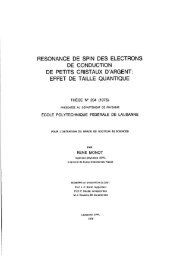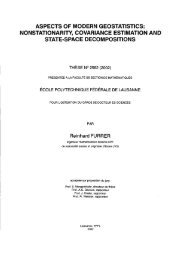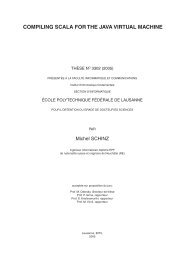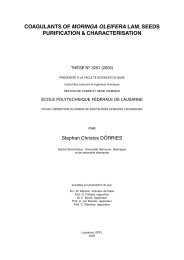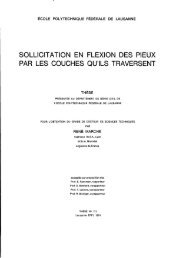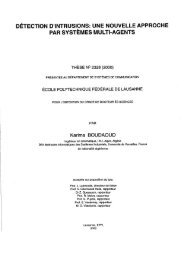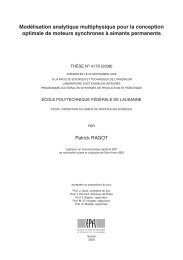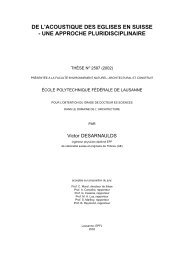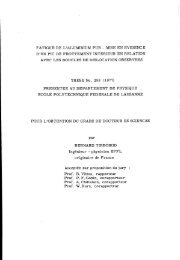Soudure par interdiffusion dans les systèmes Au-In et In-Ni ...
Soudure par interdiffusion dans les systèmes Au-In et In-Ni ...
Soudure par interdiffusion dans les systèmes Au-In et In-Ni ...
You also want an ePaper? Increase the reach of your titles
YUMPU automatically turns print PDFs into web optimized ePapers that Google loves.
<strong>Soudure</strong> <strong>par</strong> <strong>interdiffusion</strong> <strong>dans</strong> <strong>les</strong> <strong>systèmes</strong> <strong>Au</strong>-<strong>In</strong> <strong>et</strong> <strong>In</strong>-<strong>Ni</strong>:<br />
application à des composants microélectroniques<br />
THÈSE N O 5342 (2012)<br />
PRÉSENTÉE LE 20 AvRIL 2012<br />
À LA FACULTÉ DES SCIENCES ET TECHNIQUES DE L'INGÉNIEUR<br />
LABORATOIRE DE SIMULATION DES MATÉRIAUX<br />
PROGRAMME DOCTORAL EN SCIENCE ET GÉNIE DES MATÉRIAUX<br />
ÉCOLE POLYTECHNIQUE FÉDÉRALE DE LAUSANNE<br />
POUR L'OBTENTION DU GRADE DE DOCTEUR ÈS SCIENCES<br />
PAR<br />
Léa DEILLON<br />
acceptée sur proposition du jury:<br />
Prof. D. Damjanovic, président du jury<br />
Prof. M. Rappaz, Dr A. Hessler-Wyser, directeurs de thèse<br />
Prof. T. W. Clyne, rapporteur<br />
Dr T. Hessler, rapporteur<br />
Prof. R. Schaller, rapporteur<br />
Suisse<br />
2012
Abstract<br />
Hermiticity is an essential requirement of a MEMS package for a device to work properly.<br />
Herm<strong>et</strong>icity also must be preserved during the operations following packaging, during which<br />
the package bond should not remelt. Bonding temperature is limited however to avoid dam-<br />
aging the device. Solid-Liquid <strong>In</strong>terDiffusion (SLID) bonding is interesting in this context,<br />
because this process allows one to achieve bonds that are able to subsequently withstand<br />
higher temperatures than the temperature at which the bonding is done.<br />
<strong>In</strong> this work, the <strong>Au</strong>-<strong>In</strong> and <strong>In</strong>-<strong>Ni</strong> binary systems have been studied because they are good<br />
candidates to realize such bonds. <strong>In</strong>dium melts at a relatively low temperature (157°C), and<br />
all of the <strong>Au</strong>-<strong>In</strong> and <strong>In</strong>-<strong>Ni</strong> interm<strong>et</strong>allic compounds susceptible to form by <strong>interdiffusion</strong><br />
have melting points above 400°C. The optimum <strong>par</strong>am<strong>et</strong>ers for the bonding process depend<br />
strongly on the interm<strong>et</strong>allic compounds that are formed, in <strong>par</strong>ticular on their growth kin<strong>et</strong>ics.<br />
To study the <strong>Au</strong>-<strong>In</strong> and <strong>In</strong>-<strong>Ni</strong> reactions from a more fundamental point of view, diffusion<br />
coup<strong>les</strong> were fabricated. The interm<strong>et</strong>allic compounds formed in the temperature range of<br />
the bonding process have been identified, and their growth kin<strong>et</strong>ics have been d<strong>et</strong>ermined.<br />
<strong>In</strong> the <strong>Au</strong>-<strong>In</strong> system, the interm<strong>et</strong>allic compounds <strong>Au</strong><strong>In</strong>2, <strong>Au</strong><strong>In</strong> and <strong>Au</strong>7<strong>In</strong>3 were observed after<br />
heating to either 150 or 250°C, independent of the reaction time. The majority of the reaction<br />
zone consisted of <strong>Au</strong><strong>In</strong>2, growing irregularly and mainly by diffusion of <strong>In</strong>. The <strong>Au</strong><strong>In</strong> phase was<br />
observed only in a thin layer. The third interm<strong>et</strong>allic compound, <strong>Au</strong>7<strong>In</strong>3, grows in a columnar<br />
morphology and more regularly, its interface with <strong>Au</strong> being almost planar. Judging by the<br />
pores visible in the <strong>Au</strong>7<strong>In</strong>3 phase near the <strong>Au</strong> interface, probably due to the Kirkendall effect,<br />
this layer grows mainly by diffusion of <strong>Au</strong>.<br />
<strong>In</strong> the <strong>In</strong>-<strong>Ni</strong> system, only the interm<strong>et</strong>allic compound <strong>In</strong>7<strong>Ni</strong>3 was observed after the sample<br />
was treated at 200 or 300°C. This interm<strong>et</strong>allic compound grows in the form of fine columns,<br />
mainly by <strong>In</strong> diffusion. A latency period is observed before this growth starts, probably due to<br />
the presence of an oxide layer on the initial surface of the nickel.<br />
A front-tracking 1D computational model considering only the diffusion of <strong>In</strong> was developed<br />
in order to reproduce the growth of the interm<strong>et</strong>allic compounds observed. Diffusion in<br />
v
the <strong>Au</strong> and <strong>Ni</strong> phases is computed by discr<strong>et</strong>ization of Fick’s second law. Because the inter-<br />
m<strong>et</strong>allic compounds are stœchiom<strong>et</strong>ric, and thus have fixed compositions, atomic fluxes<br />
were d<strong>et</strong>ermined from the gradients of chemical potential. The velocities of the interfaces<br />
were then obtained by applying mass and solute conservation equations, in which the density<br />
differences b<strong>et</strong>ween phases were taken into account. The physical <strong>par</strong>am<strong>et</strong>ers needed as input<br />
for the model are the diffusion coefficients and atomic mobilities of <strong>In</strong> in the various phases.<br />
These <strong>par</strong>am<strong>et</strong>ers are not known precisely, and thus they were treated as fitting <strong>par</strong>am<strong>et</strong>ers to<br />
reproduce the <strong>par</strong>abolic growth kin<strong>et</strong>ics d<strong>et</strong>ermined experimentally. Finally, the temperature<br />
dependence of the diffusion coefficients in the various phases was deduced.<br />
Bonding tests were also performed by joining glass substrates on which bonding frames had<br />
been deposited. The best <strong>Au</strong>-<strong>In</strong> bonds were obtained by treating at 200°C for 15 min with an<br />
applied pressure of 2.3 MPa. When the nominal composition was near 60 at. % <strong>In</strong>, about 17%<br />
of the sealings were herm<strong>et</strong>ic. The numerical model, developed for semi-infinite domains,<br />
was adapted to simulate the bonding process, i.e. in a system of finite size. The computations<br />
reproduce the experimental observations well. Thus, the model can be used with confidence<br />
to predict the optimal bonding temperature and time as a function of the initial <strong>Au</strong> and <strong>In</strong><br />
thicknesses.<br />
The <strong>In</strong>-<strong>Ni</strong> bonding tests were not conclusive. Ternary <strong>Au</strong>-<strong>In</strong>-<strong>Ni</strong> bonds were also fabricated.<br />
Two ternary phases, each having different compositions and structures, were formed in this<br />
case. The herm<strong>et</strong>icity results obtained were promising. However, this ternary system is rel-<br />
atively unknown, and therefore it is difficult to understand the microstructures formed and<br />
their evolution.<br />
Keywords: SLID bonding; herm<strong>et</strong>ic packaging; indium; gold; nickel; diffusion; interm<strong>et</strong>allic<br />
compound growth; modeling.<br />
vi
Résumé<br />
Pour le bon fonctionnement d’un dispositif de type MEMS, l’herméticité de son encapsulation<br />
est essentielle. C<strong>et</strong>te herméticité doit alors impérativement être conservée lors des opérations<br />
suivant l’encapsulation, au cours desquel<strong>les</strong> la soudure du boîtier contenant le dispositif ne<br />
doit donc pas refondre. Pour éviter de dégrader <strong>les</strong> dispositifs, la température de soudure est<br />
toutefois limitée. Dans ce contexte, le procédé de soudure <strong>par</strong> <strong>interdiffusion</strong> solide-liquide<br />
(SLID) est intéressant car il perm<strong>et</strong> de réaliser une soudure capable de supporter <strong>par</strong> la suite<br />
des températures supérieures à sa température de réalisation.<br />
Les <strong>systèmes</strong> binaires or-indium <strong>et</strong> indium-nickel ont été étudiés car ils sont de bons candidats<br />
pour la réalisation de tel<strong>les</strong> soudures. L’indium fond en eff<strong>et</strong> à basse température (157°C) <strong>et</strong><br />
tous <strong>les</strong> intermétalliques <strong>Au</strong>-<strong>In</strong> <strong>et</strong> <strong>In</strong>-<strong>Ni</strong> susceptib<strong>les</strong> d’être formés <strong>par</strong> <strong>interdiffusion</strong> ont des<br />
points de fusion supérieurs à 400°C. Les <strong>par</strong>amètres optimaux de soudure dépendent alors<br />
fortement des intermétalliques formés, notamment de leur cinétique de croissance.<br />
Afin d’étudier <strong>les</strong> réactions <strong>Au</strong>-<strong>In</strong> <strong>et</strong> <strong>In</strong>-<strong>Ni</strong> d’un point de vue plus fondamental, des coup<strong>les</strong><br />
de diffusion ont tout d’abord été réalisés. Les intermétalliques formés <strong>dans</strong> la gamme de<br />
température de réalisation des soudures ont été identifiés <strong>et</strong> leurs cinétiques de croissance<br />
ont pu être déterminées.<br />
Dans le système or-indium, <strong>les</strong> intermétalliques <strong>Au</strong><strong>In</strong>2, <strong>Au</strong><strong>In</strong> <strong>et</strong> <strong>Au</strong>7<strong>In</strong>3 sont observés à 150 <strong>et</strong> à<br />
250°C, indépendamment du temps de réaction. La majorité de la zone de réaction est formée<br />
d’<strong>Au</strong><strong>In</strong>2, qui croît irrégulièrement <strong>et</strong> principalement <strong>par</strong> diffusion de l’indium. La phase <strong>Au</strong><strong>In</strong><br />
n’est quant à elle observée qu’en couche mince. Le troisième intermétallique, <strong>Au</strong>7<strong>In</strong>3, croît<br />
de manière colonnaire <strong>et</strong> plus régulièrement, son interface avec <strong>Au</strong> étant presque plane. A<br />
en juger <strong>par</strong> <strong>les</strong> pores visib<strong>les</strong> <strong>dans</strong> c<strong>et</strong>te phase à proximité de l’interface avec <strong>Au</strong>, provenant<br />
probablement d’un eff<strong>et</strong> Kirkendall, c<strong>et</strong>te couche croît principalement <strong>par</strong> diffusion de l’or.<br />
Dans le système <strong>In</strong>-<strong>Ni</strong>, seul l’intermétallique <strong>In</strong>7<strong>Ni</strong>3 est observé à 200 <strong>et</strong> 300°C. C<strong>et</strong> intermétal-<br />
lique croît sous forme de fines colonnes, principalement <strong>par</strong> diffusion de l’indium. Un temps<br />
de latence est observé avant que c<strong>et</strong>te croissance ne débute, probablement dû à la présence<br />
d’une couche d’oxyde sur le <strong>Ni</strong>.<br />
vii
Un modèle monodimensionnel a été développé afin de reproduire la croissance des intermé-<br />
talliques observés. Seule la diffusion des atomes d’<strong>In</strong> est alors considérée. Dans <strong>les</strong> phases <strong>Au</strong><br />
<strong>et</strong> <strong>Ni</strong>, la diffusion est calculée <strong>par</strong> discrétisation de la seconde loi de Fick. Dans <strong>les</strong> intermétal-<br />
liques, qui sont stœchiométriques, <strong>les</strong> flux atomiques sont en revanche déterminés à <strong>par</strong>tir<br />
des gradients de potentiel chimique. Les vitesses des interfaces sont ensuite obtenues grâce<br />
aux équations de conservation de masse <strong>et</strong> de soluté, <strong>dans</strong> <strong>les</strong>quel<strong>les</strong> <strong>les</strong> différences de densité<br />
entre <strong>les</strong> phases sont prises en compte. Les <strong>par</strong>amètres physiques inconnus du modèle sont<br />
<strong>les</strong> coefficients de diffusion <strong>et</strong> <strong>les</strong> mobilités atomiques de l’<strong>In</strong> <strong>dans</strong> <strong>les</strong> différentes phases. Ces<br />
<strong>par</strong>amètres ont donc été ajustés afin de reproduire <strong>les</strong> cinétiques de croissance <strong>par</strong>aboliques<br />
déterminées expérimentalement. Les coefficients de diffusion <strong>dans</strong> <strong>les</strong> différentes phases en<br />
fonction de la température ont finalement été déduits de ces simulations.<br />
Des tests de scellement ont également été réalisés, principalement <strong>par</strong> assemblage de sub-<br />
strats en verre sur <strong>les</strong>quels des cadres de soudure ont été déposés. Les meilleures soudures<br />
<strong>Au</strong>-<strong>In</strong> ont été obtenues à 200°C pendant 15 min avec une pression de 2.3 MPa. Lorsque la com-<br />
position nominale est proche de 60% at. d’<strong>In</strong>, environ 17% des scellements sont hermétiques.<br />
Le modèle numérique, développé pour des domaines semi-infinis, a été adapté afin de simuler<br />
ce procédé de soudure, c’est-à-dire en considérant une taille de système finie. Les simulations<br />
reproduisent alors assez bien <strong>les</strong> observations expérimenta<strong>les</strong>. Le modèle peut donc servir à<br />
prédire la température <strong>et</strong> la durée optima<strong>les</strong> de scellement en fonction des épaisseurs initia<strong>les</strong><br />
d’or <strong>et</strong> d’indium.<br />
Les tests de scellement <strong>In</strong>-<strong>Ni</strong> n’étant pas concluants, des soudures <strong>Au</strong>-<strong>In</strong>-<strong>Ni</strong> ont également<br />
été réalisées. Deux phases ternaires, de compositions <strong>et</strong> de structures différentes, sont alors<br />
formées. Les rendements d’herméticité obtenus sont encourageants mais, ce système ternaire<br />
étant méconnu, il est difficile de réellement comprendre la formation <strong>et</strong> l’évolution des micro-<br />
structures observées.<br />
Mots-clés : soudure SLID ; encapsulation hermétique ; indium ; or ; nickel ; diffusion ; crois-<br />
sance d’intermétalliques ; modélisation.<br />
viii
Table des matières<br />
Remerciements iii<br />
Abstract / Résumé v<br />
1 <strong>In</strong>troduction 1<br />
1.1 Problématique . . . . . . . . . . . . . . . . . . . . . . . . . . . . . . . . . . . . . . . 1<br />
1.2 Objectifs . . . . . . . . . . . . . . . . . . . . . . . . . . . . . . . . . . . . . . . . . . 4<br />
1.2.1 <strong>In</strong>troduction à la soudure SLID . . . . . . . . . . . . . . . . . . . . . . . . . 4<br />
1.2.2 Structure de la thèse . . . . . . . . . . . . . . . . . . . . . . . . . . . . . . . 6<br />
2 Revue bibliographique 7<br />
2.1 Diffusion . . . . . . . . . . . . . . . . . . . . . . . . . . . . . . . . . . . . . . . . . . 7<br />
2.1.1 Généralités . . . . . . . . . . . . . . . . . . . . . . . . . . . . . . . . . . . . . 7<br />
2.1.2 Coefficients d’<strong>interdiffusion</strong> . . . . . . . . . . . . . . . . . . . . . . . . . . 9<br />
2.1.3 Eff<strong>et</strong> Kirkendall . . . . . . . . . . . . . . . . . . . . . . . . . . . . . . . . . . 10<br />
2.2 Croissance d’intermétalliques . . . . . . . . . . . . . . . . . . . . . . . . . . . . . 13<br />
2.2.1 Croissance d’intermétalliques . . . . . . . . . . . . . . . . . . . . . . . . . 13<br />
2.2.2 Modélisation de la croissance des intermétalliques . . . . . . . . . . . . . 15<br />
2.3 Le procédé SLID/TLP . . . . . . . . . . . . . . . . . . . . . . . . . . . . . . . . . . . 17<br />
2.3.1 Description <strong>et</strong> <strong>par</strong>amètres importants . . . . . . . . . . . . . . . . . . . . . 18<br />
2.3.2 Modélisation du procédé . . . . . . . . . . . . . . . . . . . . . . . . . . . . 22<br />
2.4 Le système or-indium . . . . . . . . . . . . . . . . . . . . . . . . . . . . . . . . . . 25<br />
2.4.1 Données thermodynamiques . . . . . . . . . . . . . . . . . . . . . . . . . . 25<br />
2.4.2 Cinétiques de croissance <strong>et</strong> morphologies des intermétalliques . . . . . 27<br />
2.4.3 Réalisation de soudures . . . . . . . . . . . . . . . . . . . . . . . . . . . . . 31<br />
2.5 Le système indium-nickel . . . . . . . . . . . . . . . . . . . . . . . . . . . . . . . . 32<br />
2.5.1 Données thermodynamiques . . . . . . . . . . . . . . . . . . . . . . . . . . 32<br />
2.5.2 Cinétiques de croissance <strong>et</strong> morphologies des intermétalliques . . . . . 34<br />
2.6 Similitudes avec d’autres <strong>systèmes</strong> . . . . . . . . . . . . . . . . . . . . . . . . . . . 36<br />
3 Méthodes expérimenta<strong>les</strong> <strong>et</strong> description du modèle développé 39<br />
3.1 Propriétés physiques des métaux de base . . . . . . . . . . . . . . . . . . . . . . . 39<br />
3.2 Coup<strong>les</strong> de diffusion . . . . . . . . . . . . . . . . . . . . . . . . . . . . . . . . . . . 39<br />
3.2.1 Dispositif experimental . . . . . . . . . . . . . . . . . . . . . . . . . . . . . 39<br />
ix
Table des matières<br />
3.3 Tests de scellement . . . . . . . . . . . . . . . . . . . . . . . . . . . . . . . . . . . . 41<br />
3.3.1 Techniques de déposition . . . . . . . . . . . . . . . . . . . . . . . . . . . . 41<br />
3.3.2 Etapes préliminaires <strong>et</strong> dispositif de scellement . . . . . . . . . . . . . . . 42<br />
3.4 Techniques de caractérisation . . . . . . . . . . . . . . . . . . . . . . . . . . . . . 44<br />
3.4.1 Microscopie électronique à balayage <strong>et</strong> spectrométrie de rayons X . . . . 44<br />
3.4.2 Méthode de mesure des épaisseurs . . . . . . . . . . . . . . . . . . . . . . 45<br />
3.4.3 Spectrométrie de masse d’ions secondaires . . . . . . . . . . . . . . . . . 46<br />
3.4.4 Spectroscopie d’électrons <strong>Au</strong>ger . . . . . . . . . . . . . . . . . . . . . . . . 47<br />
3.4.5 Tests d’herméticité . . . . . . . . . . . . . . . . . . . . . . . . . . . . . . . . 47<br />
3.4.6 Tests de résistance mécanique . . . . . . . . . . . . . . . . . . . . . . . . . 48<br />
3.5 Description du modèle développé . . . . . . . . . . . . . . . . . . . . . . . . . . . 49<br />
3.5.1 Hypothèses . . . . . . . . . . . . . . . . . . . . . . . . . . . . . . . . . . . . 49<br />
3.5.2 Paramètres thermodynamiques . . . . . . . . . . . . . . . . . . . . . . . . 50<br />
3.5.3 Discrétisation <strong>et</strong> initialisation . . . . . . . . . . . . . . . . . . . . . . . . . . 54<br />
3.5.4 Calcul des vitesses . . . . . . . . . . . . . . . . . . . . . . . . . . . . . . . . 57<br />
3.5.5 Densités . . . . . . . . . . . . . . . . . . . . . . . . . . . . . . . . . . . . . . 59<br />
4 Résultats : système <strong>Au</strong>-<strong>In</strong> 61<br />
4.1 Coup<strong>les</strong> de diffusion . . . . . . . . . . . . . . . . . . . . . . . . . . . . . . . . . . . 61<br />
4.1.1 Morphologie de la zone de réaction . . . . . . . . . . . . . . . . . . . . . . 61<br />
4.1.2 Cinétiques de croissance . . . . . . . . . . . . . . . . . . . . . . . . . . . . 68<br />
4.1.3 Diffusion de <strong>In</strong> <strong>dans</strong> la phase <strong>Au</strong> . . . . . . . . . . . . . . . . . . . . . . . . 73<br />
4.2 Modélisation de la croissance des intermétalliques . . . . . . . . . . . . . . . . . 80<br />
4.2.1 Correspondance avec <strong>les</strong> résultats des coup<strong>les</strong> de diffusion . . . . . . . . 80<br />
4.2.2 Coefficients de diffusion en fonction de la température . . . . . . . . . . 84<br />
4.3 Tests de scellement . . . . . . . . . . . . . . . . . . . . . . . . . . . . . . . . . . . . 85<br />
4.3.1 Résultats préliminaires . . . . . . . . . . . . . . . . . . . . . . . . . . . . . . 85<br />
4.3.2 Microstructures des soudures . . . . . . . . . . . . . . . . . . . . . . . . . . 87<br />
4.3.3 Caractérisation de l’herméticité . . . . . . . . . . . . . . . . . . . . . . . . 90<br />
4.3.4 Résistance mécanique : tests de cisaillement . . . . . . . . . . . . . . . . . 93<br />
4.4 Modélisation d’un procédé de soudure . . . . . . . . . . . . . . . . . . . . . . . . 95<br />
4.5 Caractérisation de l’oxydation <strong>par</strong> analyses chimiques . . . . . . . . . . . . . . . 98<br />
4.5.1 Analyses <strong>par</strong> spectroscopie <strong>Au</strong>ger . . . . . . . . . . . . . . . . . . . . . . . 98<br />
4.5.2 Analyses <strong>par</strong> spectroscopie de masse d’ions secondaires . . . . . . . . . . 101<br />
5 Résultats : système <strong>In</strong>-<strong>Ni</strong> 103<br />
x<br />
5.1 Coup<strong>les</strong> de diffusion . . . . . . . . . . . . . . . . . . . . . . . . . . . . . . . . . . . 103<br />
5.1.1 Morphologie de la zone de réaction . . . . . . . . . . . . . . . . . . . . . . 103<br />
5.1.2 Cinétiques de croissance . . . . . . . . . . . . . . . . . . . . . . . . . . . . 108<br />
5.2 Modélisation de la croissance des intermétalliques . . . . . . . . . . . . . . . . . 110<br />
5.2.1 Correspondance avec <strong>les</strong> résultats expérimentaux . . . . . . . . . . . . . 110<br />
5.2.2 Coefficients de diffusion en fonction de la température . . . . . . . . . . 113<br />
5.3 Tests de scellement . . . . . . . . . . . . . . . . . . . . . . . . . . . . . . . . . . . . 113
Table des matières<br />
5.3.1 <strong>Soudure</strong>s <strong>In</strong>-<strong>Ni</strong> . . . . . . . . . . . . . . . . . . . . . . . . . . . . . . . . . . 113<br />
5.3.2 <strong>Soudure</strong>s <strong>Au</strong>-<strong>In</strong>-<strong>Ni</strong> . . . . . . . . . . . . . . . . . . . . . . . . . . . . . . . . 114<br />
6 Conclusions <strong>et</strong> perspectives 119<br />
6.1 Conclusions <strong>Au</strong>-<strong>In</strong> . . . . . . . . . . . . . . . . . . . . . . . . . . . . . . . . . . . . 119<br />
6.1.1 Croissance des intermétalliques . . . . . . . . . . . . . . . . . . . . . . . . 119<br />
6.1.2 Réalisation de soudures . . . . . . . . . . . . . . . . . . . . . . . . . . . . . 123<br />
6.2 Conclusions <strong>In</strong>-<strong>Ni</strong> . . . . . . . . . . . . . . . . . . . . . . . . . . . . . . . . . . . . . 123<br />
6.2.1 Croissance des intermétalliques . . . . . . . . . . . . . . . . . . . . . . . . 123<br />
6.2.2 Réalisation de soudures . . . . . . . . . . . . . . . . . . . . . . . . . . . . . 124<br />
6.3 Conclusions généra<strong>les</strong> . . . . . . . . . . . . . . . . . . . . . . . . . . . . . . . . . . 124<br />
6.4 Perspectives . . . . . . . . . . . . . . . . . . . . . . . . . . . . . . . . . . . . . . . . 125<br />
A Propriétés utilisées pour la simulation Abaqus 127<br />
Bibliographie 129<br />
Liste des symbo<strong>les</strong> 133<br />
Curriculum Vitae 135<br />
xi



